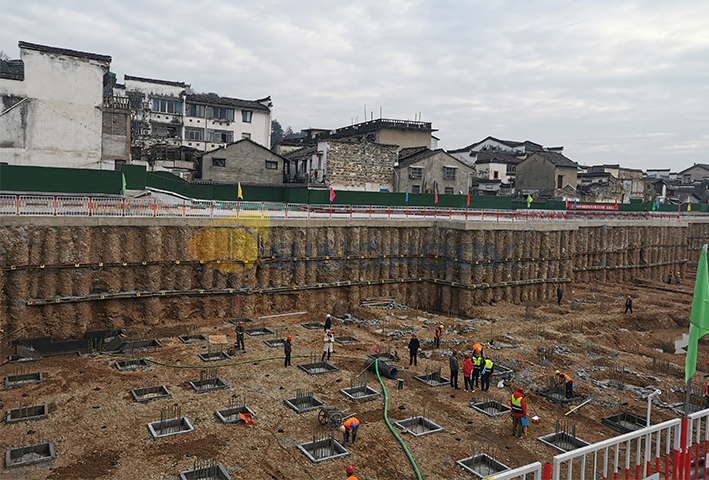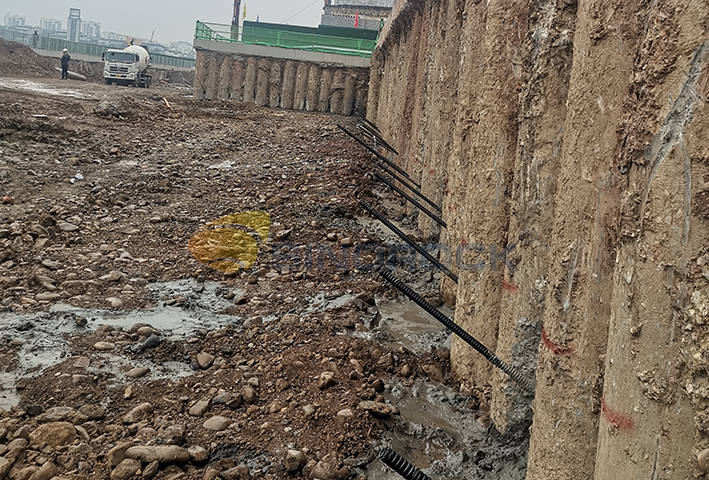Advantages of self drilling hollow anchor bolts used as soil nails
Time:2024-03-20From:sinorock View:
I. Introduction
In the realm of construction and geotechnical engineering, the use of soil nails for reinforcing slopes, mountains, dams, and building foundations has become indispensable. However, the conventional method of installing soil nails involves drilling holes first and then embedding anchor bars in the holes and grouting and fixing, which is not without its challenges. In recent years, the emergence of self-drilling hollow anchor bolts has improved this process, offering a simpler and more efficient solution. This article aims to delve into the advantages of employing self-drilling hollow anchor bolts as soil nails, elucidating their significance in modern construction practices.

II. What Are Self-Drilling Hollow Anchor Bolts?
A. Definition and Characteristics
Self-drilling hollow anchor bolts are specialized anchoring systems that combine drilling, grouting, and anchoring functions in a single process. Their hollow design of the anchor bar facilitates simultaneous drilling and grouting, improving efficiency and reducing construction time. These anchor bolts are typically composed of high-strength materials, ensuring reliable performance in diverse geological conditions.
B. How They Differ from Traditional Anchor Bolts
In contrast to traditional anchor bolts, which require pre-drilled holes and separate grouting processes, self-drilling hollow anchor bolts streamline the entire installation process. By integrating drilling and grouting functions, they eliminate the need for casing pipes and simplify construction procedures, resulting in significant time and cost savings.
C. Applications in Construction and Geotechnical Engineering
Self-drilling hollow anchor bolts find extensive applications in various construction and geotechnical engineering projects, including slope stabilization, tunneling, foundation reinforcement, and retaining wall construction. Their versatility and efficiency make them ideal for projects where conventional methods may be impractical or time-consuming.
D. Construction Process of Self-Drilling Hollow Anchor Bolts
The construction process of self-drilling hollow anchor bolts involves several steps:
1. Preparation Work: Ensuring the functionality of drilling rigs, inspecting drill bits and anchor rods, and preparing for installation.
2. Drilling and Grouting: Connecting the anchor rod and grouting pipe to the drilling rig and simultaneously drilling and grouting.
3. Coupler Installation: Using couplers if necessary to reach the desired drilling depth.
4. Plate and Nut Installation: Installing plates and nuts after grouting to ensure anchoring effectiveness.
5. Field Testing: Conducting pull-out force tests to verify compliance with design requirements.

III. Advantages of Using Self-Drilling Hollow Anchor Bolts as Soil Nails
A. Increased Efficiency and Time-Saving Benefits
One of the primary advantages of self-drilling hollow anchor bolts is their ability to streamline the construction process, significantly reducing installation time and labor costs. By eliminating the need for casing pipes and separate grouting procedures, these anchor bolts offer a more efficient and time-saving alternative to traditional methods.
B. Improved Load Transfer and Anchoring Capacity
The simultaneous drilling and grouting process of self-drilling hollow anchor bolts ensures better load transfer and anchoring capacity compared to conventional soil nails. By maximizing the shear force of the grout body/soil interface, these anchor bolts enhance structural stability and longevity, particularly in challenging geological conditions. The high-pressure grouting process can inject the cement grout into the loose stratum, greatly increasing the grout diameter and its friction force, and the anchoring quality is better than that of solid soil nails.
C. Reduced Risk of Grout Loss and Soil Contamination
The integrated design of self-drilling hollow anchor bolts minimizes the risk of grout loss and soil contamination during installation. Simultaneous drilling and grouting process is less vibrating, which effectively reduces the interference to the surrounding soil. These anchor bolts create a more secure and stable bond between the anchor rod and the surrounding soil, reducing the likelihood of failure or corrosion over time.
D. Ability to Be Installed in a Variety of Soil Conditions
Self-drilling hollow anchor bolts are versatile solutions that can be installed in a wide range of soil conditions, including loose or easily collapsed geological formations. Their adaptability to different terrains and environments makes them suitable for various construction projects, from urban infrastructure development to remote mining operations.
E. Cost-Effectiveness Compared to Traditional Methods
In addition to their efficiency and performance benefits, self-drilling hollow anchor bolts offer significant cost savings over traditional methods. By reducing construction time, labor expenses, and material wastage, these anchor bolts help optimize project budgets and enhance overall profitability for construction companies and contractors.
IV. Conclusion
Self-drilling hollow anchor bolts represent a significant advancement in ground support technology and significantly improved efficiency, versatility, and cost-effectiveness in soil reinforcement applications. By integrating drilling, grouting, and anchoring functions into a single process, these anchor bolts provide a more streamlined solution for stabilizing slopes, reinforcing foundations, and enhancing overall construction safety and resilience.
As a professional ground support expert, Sinorock brings years of experience and expertise to provide anchoring products. Please feel free to reach out to Sinorock at sinorock@sinorockco.com for any questions or requirements related to rock bolts.
latest news
-

- What Are the Applications of SDA Bolts in Hydropower Stations?
- Time:2025-08-21From:This Site
- Learn how self-drilling anchor bolts enhance slope stability, tunnel support, and dam reinforcement in complex geological conditions at hydropower stations. Optimize hydropower projects with efficient, cost-effective, and eco-friendly solutions.
- View details
-

- Slope Stabilization with SDA Bolts: Benefits & Applications
- Time:2025-08-19From:This Site
- Discover how self-drilling anchor bolts (SDA bolts) provide superior slope stabilization for highways, railways, and tunnels. Learn their key benefits, installation process, and real-world applications in loose or collapsible soils.
- View details
-

- How Self-Drilling Rock Bolts Enhance Tunnel Support in Fractured Rock?
- Time:2025-08-15From:This Site
- Discover how self-drilling rock bolts enhance tunnel support in fractured rock. Learn their benefits, installation steps, and real-world applications for safe, efficient tunneling.
- View details
-

- Sinorock 2025 Quality Month | Strengthening Quality Foundations, Empowering Product Excellence
- Time:2025-08-13From:This Site
- Sinorock’s 2025 Quality Month, themed “Strengthening Quality Foundations, Empowering Product Excellence,” successfully concluded, reinforcing our commitment to superior product quality.
- View details
-

- Sinorock Safety Month 2025 | Everyone Speaks Safety, Everyone Can Respond
- Time:2025-07-03From:This Site
- Sinorock Safety Month 2025, centered on the theme "Everyone Speaks Safety, Everyone Can Respond - Spot Workplace Hazards," has wrapped up successfully!
- View details
-

- Quality Control: the Vital Factor of A SDA Bolt Factory
- Time:2025-01-09From:This Site
- Sinorock’s comprehensive quality control system, from supplier management to outgoing inspections, ensuring the highest standards for self-drilling anchor bolts in construction.
- View details
-

- Sinorock Invites You to Explore Proven Self-Drilling Anchor Bolt Solutions at bauma 2025
- Time:2025-03-07From:This Site
- From April 7–13, 2025, explore Sinorock’s Self-drilling anchor bolt solution at Booth C2.513/4 in Hall C2 of the Messe München Exhibition Center (Munich, Germany).
- View details
-
.jpg)
- SINOROCK to Attend EXPOMINA PERÚ 2024 in Lima, Peru
- Time:2024-08-10From:This Site
- Sinorock to Attend EXPOMINA PERÚ 2024 in Lima, Peru
- View details
-
.jpg)
- SINOROCK to Participate in MINING AND METALS CENTRAL ASIA 2024
- Time:2024-08-08From:This Site
- SINOROCK to Participate in MINING AND METALS CENTRAL ASIA 2024
- View details
 Download
Download 


